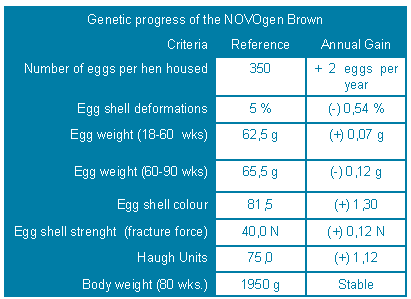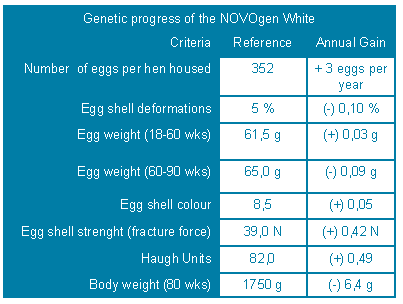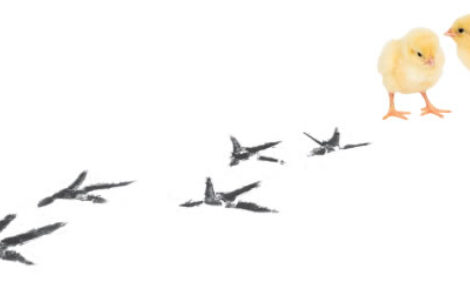



Significant Genetic Progress at Novogen
The results already seen in the field and the expectations for the latest generations (2012-2013) of the Novogen products are presented in the company's latest newsletter.The technical performance of the Novogen flocks
in the field fully confirms that Novogen is a serious
player in the selection of layers offering a genetic
solution for the different market requirements. The
Novogen Brown and Novogen White are now well-recognised
for their excellent performance for as well
as egg production and egg quality as feed efficiency.
After several years of gathering field results, the genetic
progress is very clear. This validates the company's choice for an
innovating and efficient selection programme, based on a
mix of selection in colony cages and individual cages
focussing on four main criteria:
- Egg quality
- Longevity of the flocks through a better persistency and liveability
- Feed efficiency
- Ability to adapt to different conditions
In addition, the genetic progress achieved on our R&D farms being validated by several tests under field conditions predict a significant improvement in the years to come.
Constantly Improving Egg Quality
As already mentioned many times, the egg quality
is an essential criterion in the selection programme of
Novogen to assure an excellent quality from the
beginning till the end of a production cycle.
At this moment, the genetic progress on the egg shell
colour is very significant. In comparison with our
competition, the Novogen products have improved
much faster. This will allow the Novogen Brown to be
equal or even better in egg shell colour than the best
breed in the market.

A higher value indicates a darker egg shell colour.
(Hatch date: week 28, 2011)
Regarding the egg shell strength, there is a a
clear and consistent improvement till the end of lay.
This allows customers to keep their flocks longer and
longer and to take profit out of the improved persistency
of production.
Novogen does not forget the specific work on the egg weight
curve searching for the maximum number of saleable
consumption eggs, a rapid increase at the onset of lay
and to maintain the right weight till the end.
Longevity and Persistency
In terms of productivity, many years ago,
Novogen has initiated to use selection cycles
of 90 weeks, which are much longer than the normal
production cycles in the field. The Novogen genetic
lines therefore largely profit from this with a significantly
improved persistency, which you can see in the actual
product performances.
The work done in colony cages together with the
analysis of the birds' behaviour in floor systems
continuously improves the longevity of the Novogen
layers, especially in the alternative housing systems or
enriched cages.
The Novogen Brown and Novogen White are also
well-recognised for being a calm bird and the ease
of managements in rearing and production, which
improves the liveability and feed conversion.

Feed Efficiency
One of the objectives of our selection programme is to
improve the productivity by maintaining the same level
of feed consumption and lowering the capacity of the
birds to become fat at the end of the production cycle,
which lowers the feed required for maintenance. This
allows a continuous improvement of the feed efficiency
without compromising the bird’s reserves.
The selection programme also continues to focus on the
persistency of lay till over 90 weeks of age, leading to a
constant improvement of the feed conversion. The feed
intake capacity remains intact, which does not require
using the reserves too much during the laying period.
This can then be used for increasing the egg mass
produced by hen housed.
Ability to Adapt to Various Field Conditions
This criterion is really a specific feature of the Novogen layers. The sales of the Novogen breeders in all major egg-producing countries is the best proof of its ability to express its genetic potential under many different field conditions: hot climates or moderate climates, open-sided houses or environmentally controlled houses, in cages of alternative systems and with different types of feed used.

The originality of Novogen’s selection programme lies in its ability to challenge some basic principles of selection
to what had been used in other companies. Novogen's approach on the criteria of liveability and behaviour
in rearing and production are the best examples through a mixed selection program using colony and individual
cages and an analysis of the behaviour on the floor of the different lines.
The Company's original way of thinking and expertise are the main ground for all work done on the selection criteria, allowing
the genetic progress seen on its test farms and on commercial farms in the field.

Over the last 25 years, the selection for productivity has led to an increase of 70 eggs and 5kg of egg mass at 70 weeks. At the other side feed efficiency, expressed as kg of feed per kg of eggs produced, has gone from 3 to 2. This gain is enormous if one considers that feed costs are about 60 per cent to 70 per cent of the total production costs. Such progress demands a continuous adaptation of the management techniques and feed in the rearing and production period.
Controlling Feed Intake
During the 10 first weeks, the pullets do not control their
feed intake related to the energy content of the feed.
Hence, in this period any increase of energy in the feed
stimulates the growth of the birds.
That is why it is recommended to use a high-energy
feed during the first five weeks of the rearing period.
This promotes the consumption because of the easier uptake and the reduction in eating time. This
improves as well as the growth of the pullet as the feed
conversion.
Pullets are grain eaters and their consumption depends
on the presentation, and in particular the particle size of
the feed. As from five weeks of age, the recommendations
are as follows:
- Particles <0.5mm: 15 per cent maximum
- Particles >3.2mm: 10 per cent maximum
At least 75 per cent to 80 per cent of the particles should have a size between 0.5 and 3.2mm.

October 2012








